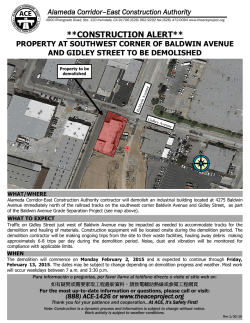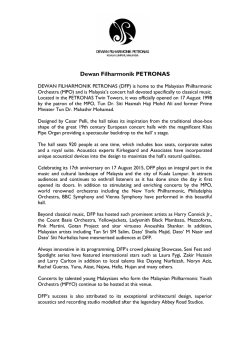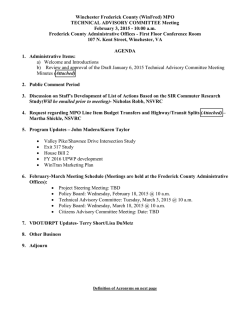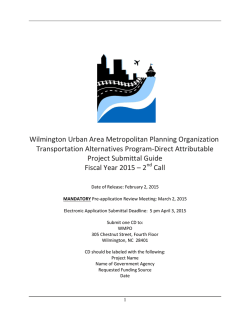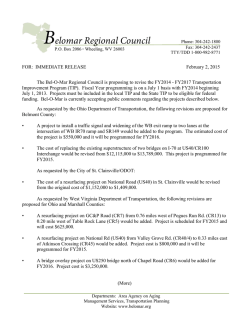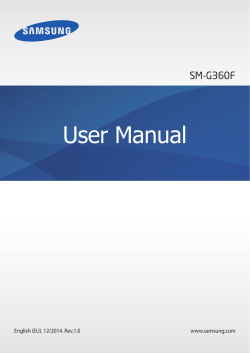
January 30, 2015 - Mobile Metropolitan Planning Organization
From: To: Subject: Date: Attachments: Transportation Dept Transportation Dept Transportation Friday, January 30, 2015 Friday, January 30, 2015 10:49:35 AM image002.png oledata.mso Transportation Friday An electronic newsletter concerning regional transportation issues Friday, January 30, 2015 In This Issue · MOBILE MPO UPDATES Volume 13, Number 5 The DESTINATION 2040 PUBLIC MEETING was last night, and the Gulf Coast Phase 2 Climate Change Study Roll Out was last week; please see Mobile MPO Updates. Boehner kills idea of a gas tax, Senators Rand Paul (R-KY) and Barbara Boxer (D-CA) introduce infrastructure funding proposal announcement and Transportation Sec. Foxx said ”to the hell with politics”; please see Legislative Updates. This week’s Just For Fun is going green, green as grass for the Super Bowl. Anthony Johnson, Monica Williamson, Tom Piper, and Kevin Harrison, PTP · PROJECTS LET JANUARY 30 TH , 2015 · LEGISLATIVE UPDATES · FUNDING OPPORTUNITIES · JUST FOR FUN · IN THE NEWS · TRANSPORTATION RESEARCH www.mobilempo.org 706-1CAR check us out on FACEBOOK Mobile MPO Updates DESTINATION 2040 A public meeting was held last night for the Mobile MPO Long Range Transportation Plan, Destination 2040. The Plan is on the March 4th, 2015 MPO agenda for adoption. Despite a fire alarm, and the fire department, we had a pretty good crowd at last night’s public meeting. The projects were reviewed, and we had several comments, mainly concerning transit and bicycle / pedestrian facilities. Recently Completed Planning Studies Origin Destination Study Using Cell Phones Mobile County Comprehensive Bicycle and Pedestrian Plan Intelligent Transportation System Diversion Route Planning Study Contact Us http://www.mobilempo.org [email protected] Kevin Harrison, PTP Director of Transportation [email protected] There are over a Billion dollars’ worth of road projects planned in the Mobile Urban Area in the next 25 years. A large portion of those funds are of course the I-10 Mobile River Bridge, which a funding source has not yet been identified. Tom Piper Senior Transportation Planner [email protected] Monica Williamson Transportation Planner [email protected] Anthony Johnson Transportation Planner [email protected] South Alabama Regional Planning Commission 110 Beauregard St Mobile, Alabama 36602 (251) 433-6541 The plan is multi-modal in scope, encompassing long-range plans for highway, public transportation, and bicycle/pedestrian networks. Regional growth, economic development, and accessibility within the study area along with environmental concerns necessitate that the longrange plan addresses not only improved vehicular travel but also improvements to other modes of transportation such as bicycling and walking. Preservation of the existing transportation system coupled with enhancement of all modal choices will contribute to the improvement of the overall quality of life in the region. You can learn more about the plan HERE. Climate Change Phase 2 released: Since 2010, the Mobile MPO has been the pilot MPO for Climate Change. The study is complete, and very extensive. The roll out was last week with a webinar of which Kevin Harrison was on the agenda. Phase 2 focused on the Mobile, Alabama region, with the goal of enhancing regional decision makers' ability to understand potential impacts on specific critical components of infrastructure and to evaluate adaptation options. In Mobile, U.S. DOT assessed the vulnerability of the most critical transportation assets to climate change impacts. U.S. DOT will then develop risk management tools to help transportation system planners, owners, and operators determine which systems and assets to protect and how to do so. The methods and tools developed under Phase 2 are intended to be replicable to other regions throughout the country. Phase 2 was publicly released on January 22, 2015 in a live webcast. Reports and Tools Task 1: Assessing Infrastructure for Criticality in Mobile, AL. (September 1, 2011). This memo summarizes the methodology and findings of Task 1, which identified the transportation infrastructure components most critical to the Mobile region. (or PDF, 2.5MB) Task 2: (November 8, 2012) The work in Task 2 includes development of climate projections for Mobile and an assessment of the sensitivity of transportation assets to climate change and extreme weather. Both sets of information are used in the vulnerability assessment (in Task 3). Task 3: (June 2014) Task 3 comprises the vulnerability assessment of Mobile's transportation system, including a vulnerability screen of the system and detailed engineering assessments of specific facilities. Task 4: (January 2015) This task focused on development of vulnerability assessment tools for use around the country. These tools and resources were publicly released on January 22, 2015. Task 5: This task comprised public outreach logistics and coordination. No formal reports or tools were developed under Task 5. Task 6: Synthesis of Lessons Learned and Methods Applied (October 2014) This report discusses highlights of the project and lessons learned, summarizes the methodologies employed and resulting tools, and discusses areas for future work. (or PDF, 1.8 MB) Other Resources Gulf Coast Study Phase 2 Case Study (HTML) or (PDF 2.3 MB) Engineering and Task Case Studies Information Sheet for Phase 1 and Phase 2 (HTML) or (PDF, 313KB) For Further Information For further information regarding the project, please contact: Rob Kafalenos (202) 366-2079 [email protected] Rob Hyman (202) 366-5843 [email protected] Also on the agenda at the Mobile MPO Policy Committee meeting on Wednesday, March 4, 2015 is to rebalance the STP Attributable funding schedule, and discuss adding the following items to the Transportation Improvement Program (TIP). We have to build a new TIP in the next couple of months, so there will be some discussion on that was well. HSIP Funds Construct offset left turn lanes and a WB right turn lane US98 at McCrary Road; 4/24/15; $780,000 TAP Funds Mobile County Commission CN of sidewalk along Burroughs Lane from Washington Blvd to Burroughs Elementary School 4/15/2015; $15,000 Non-motorized Mobility study for Downtown Mobile We have given Toole Design Group Notice to proceed on the Non-motorized Mobility study for Downtown Mobile. If you would like to be stakeholder, please let us know. There is going to be plenty of time for public input as laid out in the scope of work HERE. I-10 Mobile River Bridge ALDOT has released the I-10 Mobile River Bridge Corridor Hearing Report Summary and it is now available online at www.mobileriverbridge.com. This report summarizes all of the comments that were received during the Draft Environmental Impact Statement public comment period in the Fall of 2014. The document suggests most of the support was for the B prime route. Although we are moving closer and closer to having a bridge, there are still several hurdles still to cross, including funding. For more information on the I-10 Mobile River Bridge: ALDOT’S Web Site: http://www.mobileriverbridge.com/ Build The I-10 Bridge Coalition Web Site: http://www.buildthei10bridge.com/ Projects Within Region Let January 30th, 2015 Baldwin County · for constructing the Resurfacing and Traffic Stripe on SR-42 (US-98) from just north of the intersection of Scenic Route US-98 to just west of CR-65. Length 10.482 mi. · for constructing the Intersection Improvements (Grade, Drain, and Pave) at SR-180 and SR161 in Orange Beach. Length 0.303 mi. · for constructing the Planing, Resurfacing, and Traffic Stripe on SR-287 from the junction of SR-3 (US-31) to the intersection of SR-59 in Bay Minette. Length 1.925 mi. · for constructing the Resurfacing and Traffic Stripe on CR-2 (Gulf State Park Road Two) from the junction of SR-135 to the junction of SR-182 in Gulf Shores. Length 3.013 mi. Mobile County · for constructing the Widening, Drainage Improvements, Resurfacing, Guardrail Installation, and Traffic Stripe on CR-70 (Tanner Williams Road) from the junction of CR-5 (Wilmer Road North) to a point 1200 feet west of the junction of Eliza Jordan Road North. Length 4.795 mi. · for constructing the Widening, Drainage Improvements, Resurfacing, and Traffic Stripe on Dawes Road from the intersection of Grand Bay - Wilmer Road to the junction of Three Notch Road. Length 4.765 mi. What’s Under Construction? Legislative Updates Foxx Testifies at EPW Hearing: At a hearing earlier this week, Transportation Secretary Anthony Foxx appeared before the Senate Environment and Public Works Committee. His testimony contained a couple of noteworthy elements. First, in a moment that has received some media attention, Foxx said, “To hell with the politics” when discussing the need for a dramatic fix for the nation’s transportation system and how it’s funded. Second, Foxx indicated that the Administration is re-working parts of its Grow America Act reauthorization proposal and will release an updated version soon. He did not say what changes can be expected, but did indicate that the pay-for would remain unchanged and any policy changes would be minor. We’ll report back when we learn more. Senators to Introduce Infrastructure Funding Proposal: Senators Rand Paul (R-KY) and Barbara Boxer (D-CA) announced yesterday they will soon introduce legislation that would reduce the tax rate on repatriated corporate earnings and commit the resulting tax collections to funding transportation projects. To encourage corporations to bring overseas earnings back onshore, the Invest in Transportation Act would reduce the tax rate on those earnings from 35 percent to 6.5 percent. That could bring as much as $2 trillion in earnings back to the U.S. according to Senators Paul and Boxer, and the taxes collected on the repatriated dollars would be committed to infrastructure. The proposal has potential political viability because it does not involve a tax increase, just taxes collected on dollars otherwise parked overseas. There is also significant political opposition to the tax holiday idea, as expressed by Senate Finance Committee Chairman Orrin Hatch (R-UT), whose committee will have final say on how any increase for infrastructure will be funded. A major concern is that this approach increases tax collections in the near term, but would have much higher long-term costs (based on the assumption that those overseas dollars would eventually come home, and at the higher rate CBO: Highway Trust Fund Still Broke: In one of its regular updates to Congress about the state of the nation’s economy, the Congressional Budget Office (CBO) indicated earlier this week that Congress needs to come up with $73 billion to pass a five-year reauthorization bill this year to make up the gap between gas tax receipts and expected funding levels. CBO assumes slow growth in the program, from approximately $54 billion this year to $60 billion by 2025. The ten-year funding gap is estimated at $169 billion. These numbers have changed little from last year, but highlight the immense challenge that lies before the Senate Finance and House Ways and Means Committees, which are responsible for finding the necessary funding for a reauthorization bill. Boehner Kills Gas Tax Talk: Comments by several Senate Republicans about increasing the federal gas tax started this Congress off with optimism about the potential for finding new federal sources of funding for transportation. But more recent comments from several members of the House have all but closed the door on this option. Most importantly, Speaker John Boehner (R-OH) basically shot down any chance of a gas tax increase this year in an interview on 60 Minutes last weekend. That said, he did leave open the possibility of using a tax reform bill to create new revenue for transportation spending. Sanders Introduces Trillion Dollar Infrastructure Bill: Earlier this week, Senator Bernie Sanders (DVT) introduced legislation that would provide $1 trillion for a wide array of infrastructure projects, including $75 billion per year for the Highway Trust Fund, funding for an infrastructure bank, and significant increases in funding for aviation, rail, water infrastructure, ports, national parks, and broadband. The bill is likely a non-starter for a variety of reasons, one of which is that it doesn’t contain a pay-for. It does, however, attempt to raise the public consciousness of the importance of investing in the nation’s infrastructure Funding Opportunities FY 2015 Transportation Alternatives Program –TAP FUNDS Deadline: May 1, 2015 Only cities and counties can apply for TAP funds, and your jurisdiction will determine your application for TAP Funds. If you are in the Mobile Urbanized Area, you are eligible for the Urban Area TAP Funds available through the Mobile MPO at South Alabama Regional Planning Commission. If you are outside of the Mobile Urbanized Area you will apply to ADLOT for TAP funds (see below). The applications, guidelines and funding limits between the STATE TAP and the URBAN TAP are slightly different. Please be aware, and if there are any question please do not hesitate to call us. The federal guidance on TAP funs is here: https://www.fhwa.dot.gov/map21/guidance/guidetap.cfm MOBILE URBANIZED TAP FUNDS The Mobile MPO announces the availability of the FY 2015 Transportation Alternatives Program (TAP) funding. The maximum amount that can be applied for with Mobile Urbanized TAP funds is $200,000 (federal). The TAP provides funding for programs and projects defined as transportation alternatives, including on- and off-road pedestrian and bicycle facilities, infrastructure projects for improving non-driver access to public transportation and enhanced mobility, community improvement activities, and environmental mitigation; recreational trail program projects; safe routes to school projects; and projects for planning, designing, or constructing boulevards and other roadways largely in the right-of-way of former Interstate System routes or other divided highways. Applications for Mobile Urban Area TAP Funds will be made available February 1, 2015. ALDOT TAP FUNDS The Alabama Department of Transportation (ALDOT) announced application availability for the FY 2015 Transportation Alternatives Program (TAP) funding. The TAP provides funding for programs and projects defined as transportation alternatives, including on- and off-road pedestrian and bicycle facilities, infrastructure projects for improving non-driver access to public transportation and enhanced mobility, community improvement activities, and environmental mitigation; recreational trail program projects; safe routes to school projects; and projects for planning, designing, or constructing boulevards and other roadways largely in the right-of-way of former Interstate System routes or other divided highways. ALDOT TAP Funding applications can only come from ALDOT [HERE]. SHRP2 Implementation Assistance Program Funding Available Applications due: February 13 As part of the second Strategic Highway Research Program (SHRP2), AASHTO and the Federal Highway Administration recently announced that the application process for the fifth round of the SHRP2 Implementation Assistance Program (IAP) is now open. MPOs, local governments, and tribal agencies are able to apply for implementation assistance. Click HERE for more information about what projects can be funded and how to apply. If you would like additional information or have questions about the Planning Process Bundle, contact Spencer Stevens at (202) 366-0149 or via email at [email protected]. The Mississippi-Alabama Sea Grant Consortium Funding Opportunity The Mississippi-Alabama Sea Grant Consortium is accepting pre-proposals for one- to two-year innovative research projects that address one of these coastal issues: Healthy Coastal Ecosystems, Sustainable Fisheries and Aquaculture or Resilient Communities and Economies. Funding requests of no more than $75,000 per year are recommended and the deadline is Feb. 20, 2015. For more information, please click here. 015 Five Star/Urban Waters Restoration Program Application Deadline: February 3 The National Fish and Wildlife Foundation (NFWF) is offering grants through the Five Star and Urban Waters Restoration Grant Program, which provides financial assistance to local partnerships for wetland, riparian, forest, and coastal habitat restoration, urban wildlife conservation, stormwater management as well as outreach, education, and stewardship. Projects should focus on water quality, watersheds, and the habitats they support. NFWF anticipates that approximately $2,100,000 in combined total funding will be available for this round of grants. Click HERE for details. HUD $1 Billion National Disaster Resilience Competition Application Deadline: March 2015 U.S. Department of Housing and Urban Development (HUD) recently launched a National Disaster Resilience Competition, which makes $1 billion available to communities that have been struck by natural disasters in recent years. The competition promotes risk assessment and planning, and will fund the implementation of innovative resilience projects to better prepare communities for future storms and other extreme events. Representatives from eligible communities will have the opportunity to attend Rockefeller-supported Resilience Academies across the country to strengthen their funding proposals. Click HERE to apply. Incentive Opportunities As the third round of the Every Day Counts initiative moves into high gear, the Federal Highway Administration is offering incentives and technical assistance to help the highway community mainstream innovations. Fiscal year 2015 assistance is now available from the State Transportation Innovation Council Incentive program. The program provides resources—technical assistance and funds—to help STICs make innovations standard practice. States can get up to $100,000 a year for activities such as implementing system process changes, organizing peer exchanges and developing guidance and specifications. Contact the state FHWA Division Office or Mary Huie at (202) 366-3039 for information . The Accelerated Innovation Deployment Demonstration program continues to accept applications through Grants.gov. Incentive funding of up to $1 million may be awarded for projects using innovation on any aspect of highway transportation, including planning, financing, environment, design, construction, materials, pavements, structures and operations. See the AID Demonstration Web page or contact Ewa Flom at (202) 366-2169 for details. Section 1304 of the Moving Ahead for Progress in the 21st Century Act allows an increase in the federal funding share of up to 5 percent on eligible projects that use innovations. Just For Fun It is Super Bowl weekend, and for past several years the Super Bowl turf comes from Baldwin County. In fact, thirty refrigerated tractor-trailer trucks hauled the turf some 1,700 miles from Bent Oak Farm in Baldwin County to Glendale, Arizona in the beginning of January. But what makes this even more Just For Fun, is that the turf… IS STILL ON A TRUCK! http://www.sciencechannel.com/tv-shows/build-it-bigger/videos/build-it-bigger-arizonas-superstadium/ In the News Gov. Bentley pitches Congress on a long-term roads funding bill, Mobile River Bridge improvements By Madison Underwood | [email protected] Email the author | Follow on Twitter on January 28, 2015 at 12:22 PM, updated January 28, 2015 at 12:29 PM Alabama Gov. Robert Bentley told the Senate's Environment and Public Works Committee Wednesday that Congress needs to pass a long-term transportation funding bill. MAPS-21, a federal highway-funding bill passed in 2012, expires in May 2015, and Congress will be considering funding options to replace that bill soon. The short-term fixes Congress has passed in the past "created uncertainty at the national level and triggered action at the state level," Bentley said. "We need certainty at the federal level so that states can plan for and make infrastructure improvements," Bentley said. "A long-term federal transportation reauthorization will provide certainty." Bentley, who appeared as vice-chair of the National Governor's Association's Economic Development and Commerce Committee, argued that the federal funds the federal government provides should be unrestricted. "When states receive federal funds that are earmarked for specific projects, it diminishes core program funding and restricts the ability of governors to maintain critical infrastructures within their states," he said. He also used to opportunity to promote Alabama before the committee. He mentioned ATRIP, the Alabama Transportation Rehabilitation and Improvement Program, a mechanism the state uses to leverage funds for road and highways projects throughout the state. Bentley noted a request for $500 million in funds to improve the Mobile River Bridge, which I-10 runs over, and took the opportunity to pitch the committee on the economic impact of the project. "The total cost to improve this bridge is nearly one billion dollars," Bentley said. "The upgrades would increase the capacity of I-10, which runs from Florida to California, to meet existing and predicted future traffic volumes and to provide a more direct route for vehicles transporting hazardous materials, while minimizing impacts to Mobile's maritime industry." A new bicycling plan for the Eastern Shore surfaces amid skepticism from motorists and government officials By John Sharp | [email protected] Email the author | Follow on Twitter on January 23, 2015 at 3:45 PM Each working day for 30 days in the heat and humidity of a South Alabama summer, Matthew Brown got on a single-speed, aluminum Mongoose bicycle he purchased for $40 at a garage sale and began peddling to work. The 1.6-mile, one-way ride to and from work took about 10 minutes. Brown rarely broke a sweat, and admittedly did not overexert himself. He documented his day-to-day experiences that are included in a bicycle-pedestrian plan the Eastern Shore Metropolitan Planning Organization is set to approve early next month. "I am still trying to keep up with that," Brown said about his daily work commute, which he replaced with driving as part of an effort to show that utilitarian cycling -- the type of trip that allows a cyclist to have an ending point of destination, as opposed to recreational and leisure cycling - can be achieved in growing communities like Fairhope, Daphne, Spanish Fort and the unincorporated areas around them. "It helped me become more conscience of cyclists and pedestrians," Brown said about his experiment. Brown's physical efforts were combined with internal research, public feedback and mapping to produce the first bicycle-pedestrian plan for the Eastern Shore. "We realize we are laying the groundwork for (MPO) committees for years to come," Phil Hooper, vice-chairman of the Eastern Shore MPO's Bicycle and Pedestrian Advisory Committee, said. "It's something we're not taking lightly." The plan is a requirement by the U.S. Department of Transportation and the Federal Highway Administration. Every MPO in the country has to develop and update a bicycle-pedestrian plan every four years. Also, MPO's are responsible for developing long-range transportation plans that also include highways and transit goals. Continue reading HERE How should Baldwin County proceed with bicycling and pedestrian access? (poll) By John Sharp | [email protected] Email the author | Follow on Twitter on January 23, 2015 at 3:45 PM As Baldwin County continues to grow, so does the demand for more recreational activities. One of the features often wanted in growing communities and counties is the addition of bicycling and pedestrian paths or access along roadways. The Eastern Shore Metropolitan Planning Organization, which was formed about two years ago when portions of Baldwin County officially became a "metro" area, recently completed a bicycling and pedestrian plan. It's a first for the Eastern Shore area that includes Spanish Fort, Daphne, Fairhope, Loxley and portions of rural and unincorporated Baldwin County. The plan is just that -- a document that guides the MPO for both short-term and long-term needs. But planners are aware that limited transportation money is available for bicycling and pedestrian features. Still, they have listed a group of short-term projects that include an educational component to inform school-aged children and companies about bicycling and pedestrian safety. Moving forward, what are your thoughts about the county's planning focus for bicycling and pedestrian features? TAKE POLL HERE Lane shift expected for Broad St. at Brookley and other road projects for Friday, Jan. 30 across Coastal Alabama By Angela Levins | [email protected] Email the author | Follow on Twitter on January 30, 2015 at 5:30 AM Traffic is expected to start flowing a little smoother along Broad Street around the Brookley Aeroplex starting Friday. Katie Hamlett, the Media and Community Relations Officer for ALDOT, told AL.com Tuesday the project manager planned for a lane shift by Friday. The lane shift is set to stripe for two lanes, which would create a way in and a way out for Fort Whiting visitors and Mardi Gras ball revelers. Wayne Hightower with Fort whiting said they are scheduled to hose six more balls for the 2015 Mardi Gras Season. Also, for the Mardi Gras season, Hamlett said ALDOT plans to put the Interstate 10 resurfacing work happening now in Mobile County on hold until Feb. 18. Here is a look at the road projects underway in Mobile and Baldwin counties that could hamper your commute. Mobile: Royal Street: Between Dauphin and Conti streets, work on the Van Antwerp building continues to hamper traffic from time to time. Be cautious of pedestrians and workers. Satchel Paige Drive: Satchel Paige Drive between Government and Bolling Brothers boulevards is closed to traffic. The road is being widened to a four-lane divided road. Work is expected to take about three months. The road project is part of the McGowin Park Shopping Center construction. Mobile County: Jackson Creek Bridge: Old Pascagoula Road is closed between Ramsey Road and March Road. Bridge being replaced. Project estimated to last a year. Schillinger Road South: Between Cottage Hill Road and Halls Mill Creek. Widening project expected to take two years to complete. Construction could cause lane shifts, but roadwork will not close area to motorists. ALDOT Mobile County: I-10: Resurfacing and bridge work from Halls Mill Creek to the west end of the George C. Wallace Tunnel. Drivers should expect nighttime closures Sunday to Thursday from 7 p.m. until 6 a.m. Work is expected to be completed next summer. U.S. 90: From Halls Mill to Pine Hill Drive. The mainline is paved on the US-90 resurfacing project. The crews are finishing turn lanes and shoulders and are still expected to have most of the work complete by the end of Jan. 2015. Welcome Center: The Welcome Center at the Alabama/Mississippi line is shut down until at least spring 2016. Temporary welcome center open at 5651 U.S. 90, Theodore, AL 36582, 251-865-4741. Directions: Take Exit 15-A on I-10, second light and take a left, follow service road and the temporary welcome center is on the left. ALDOT Baldwin County: I-10: Baldwin 68 connector to Baldwin Beach Express. Work is about 95 percent complete. Drivers may see an occasional lane closure on CR 83 for completing remaining work. Little Lagoon Pass bridge remains under construction. ALDOT reports that the work is about 65 percent complete. There is a detour bridge next to the Little Lagoon Pass bridge. Expect minimal traffic delays. Transportation Research AASHTO Completes Series of Reports Tracking Commuter Trends and Behavior WASHINGTON – America is a nation on the move – rarely more so than during its daily commute to work, which comprises approximately 28 percent of all daily trips on U.S. roadways and transit systems, according to a new research paper. Understanding how individual commuters get to work is critically important for transportation decision makers tasked with operating and maintaining the nation's transportation infrastructure. The American Association of State Highway and Transportation Officials (AASHTO) has released the final installment in a series of 16 "Commuting in America" briefs that examine a significant and evolving segment of the nation's traveling public. The final brief points to slowing growth in commuting due to the aging of the American worker and declines in the number of younger people entering the workforce. U.S. Census Bureau projections suggest the population in the working age group 18–64 will see a sharp decline over the next 20 years—approximately 6 million new potential workers from 2015 to 2030, in sharp contrast to 26 million during the period 2000 to 2012. In addition to age demographics, the authors point to potential impacts of technology and land use decisions that are likely to affect future commuting trends. For instance, recent growth of wireless devices allows transit riders to work or communicate while on buses or subways, and fast-developing technology for autonomous cars and connected vehicles could soon let roadway commuters tend to other tasks while their cars drive themselves. "Regardless of how these phenomena play out, the boom in commuting growth is behind us, at least at the national level," the brief claims. In spite of some rather significant changes in demographics, the economy, technology, and the culture and values of residents, a long-term study of available transportation data shows that commuting behaviors have changed modestly over the past decade. The Commuting in America 2013 series is used by public policy, planning, research, and education practitioners to better understand the patterns and trends in the nature of work and commuting that are influencing critical transportation policy issues and investment decisions. The briefs include topics such as worker trends, vehicle and transit availability, vehicle ownership and licensure levels. It tracks population trends and the use of transit services, biking, walking and carpool commuting options. Alan Pisarski, a transportation consultant and co-author of the series, said: "By better understanding how commuters select the mode of transportation they use, decision makers can create policies and programs to increase transit ridership, target traffic congestion and enhance the commuting experience." "Our research finds that commute trip travel time and the pattern of commute traveling have remained remarkably stable over the past decade; However, employment conditions and consequently the nature of commuting continue to be in a dynamic period," said co-author Steve Polzin, Ph.D., of the Center for Urban Transportation Research at the University of South Florida "Over time, these changes may continue to alter work-trip commuting trends and it's important to continue track this data moving forward." This is the fourth edition of Commuting in America reports published since 1987. The latest series is supported by the AASHTO Census Transportation Planning Products Program and it was developed in conjunction with the National Cooperative Highway Research Program. Download the briefs at: http://traveltrends.transportation.org Creating Smart Paths for Connected Cities February 26, 10:30AM – 12:00PM ET This webinar is intended to inform participants about the new Connected Cities Research Program, a project of U.S. DOT’s Intelligent Transportation Systems Joint Program Office (ITS JPO). The webinar follows the release of the ITS JPO white paper, The Smart/Connected City and Its Implications for Connected Transportation, which provides a foundation for the discussion. Click HERE to register. WEBINAR: National Performance Measures Research Data Set February 5, 2015, 1:00 PM FHWA's Office of Freight Management and Operations is hosting its next Quarterly Technical Assistance Webinar for the National Performance Measures Research Data Set (NPMRDS), which is the probe data that FHWA is using internally for passenger and freight analysis and making available to States and MPOs. At this webinar, FHWA and its contractors will provide an overview of the probe data set, demonstrate data applications, and respond to technical assistance questions. Click HERE to register, and HERE for more information on the data set. Bicycle Safety Guide and Countermeasure Selection System (BIKESAFE) Webinar Thursday, February 19, 2015 2:00 - 3:30 p.m. Eastern Time FHWA recently completed its update to the Bicycle Safety Guide and Countermeasure Selection System, commonly known as BIKESAFE, to reflect the latest research and best practices surrounding designs for bicycle safety. This free webinar highlights many of BIKESAFE's newest features and innovative countermeasures. Presenters will discuss how practitioners can use BIKESAFE to analyze crashes and implement new treatments as well as how to identify options to improve bicycle safety. Furthermore, presenters will discuss many of the 46 proven engineering countermeasures detailed within BIKESAFE and how communities have successfully implemented them. Finally, presenters will briefly touch on BIKESAFE's pedestrian counterpart, the Pedestrian Safety Guide and Countermeasure Selection System. Presenters include: Tamara Redmon, FHWA Office of Safety Carl Sundstrom, UNC Highway Safety Research Center Dan Nabors, Vanasse Hangen Brustlin, Inc. Peter Lagerwey, Toole Design Group To access BIKESAFE or PEDSAFE, go to: http://www.pedbikesafe.org/
© Copyright 2025

